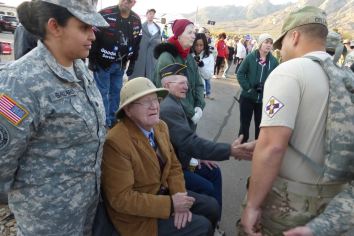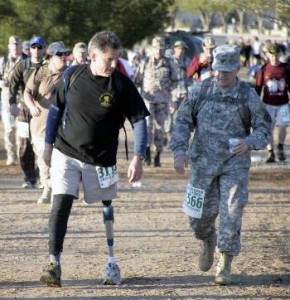This is based on my experience with the Bataan Death March Marathon. It is the second of three posts on this subject. To read the first, click here. The next post in this series will focus on Ben Steele, Bataan Death March survivor, Montana cowboy, and artist.
Why Do This?
The doctor looked at me, with my wife listening, “You can get all the cardio you need walking. If you were on active duty, I would profile you so you could not run. I suggest you stop marathons, and consider not running at all. You will not have a heart attack. With this problem, you will likely be dead before you hit the ground.”
Before that, between ages 59 and 65, I’d completed 15 marathons. Four of those, I walked. Each took me about nine hours to finish, in the Chihuahua Desert, north of El Paso, Texas. Training for such endurance events is hard. Participating is fun, but demanding. I discovered the Bataan Death March Memorial Marathon when l was searching for an off-road, full marathon for walkers. About 85% of this “March” participants walk it.
In early March of 2008, we flew from San Antonio to El Paso, rented a car, and drove 45 miles north to the US Army post at White Sands Missile Range in southeast New Mexico. I checked in at registration, looked around the base, then drove 17 miles to Las Cruses for the night.
Well before dawn the next day, my wife took me back to White Sands and stayed with me as a hoard of 5,000 marchers and runners, plus many friends, and event staff descended on the large outdoor breakfast area, next to the starting-line assembly corral.
The Emotional Start
Sunrise and the start are at about 0600 hours. Everyone arrives long before dawn. After we parked, drank coffee, juice, and I scarfed up whatever I could eat, marathon ritual requires queuing up at one of the numerous port-a-potty toilets. I watched as some male participants strolled over to the golf course to give it a watering, I would have too, but they were run off by staff. It was dark, their backs were to us, it made the loo lines shorter, and the area had little grass. I didn’t see the problem, but dropped the idea.

The opening ceremony at sunrise was the most patriotic and emotionally stirring that I ever witnessed. I was in the starting corral by that time, and being surrounded by my tribe added to my feeling of being part of something special. After few short speeches, accolades, and expressions of gratitude; a low altitude, noisy flyover of fighter jets from Holloman Air Force Base marked the final countdown to the starting gun. The crowd got quieter as the excitement and tension grew.

We were startled by a loud, unexpected blast when the starting gun was a thunderous, awakening, cannon blast. This was an Army post, so of course. As we slowly worked our way through another narrow gate and into the crowded final corral, a marching band of kilted drummers and bagpipers led the parade of 5,000 hopefuls through the 15 feet wide, by 50 feet long, starting area. Lining the sides of the narrow start area, the Bataan Death March survivors, most sitting, old and frail former POWs shook hands and spoke with as many participants as possible. Since the Bataan Death March is 75 years old now, few, if any, actual survivors remain.

We heard a distinctive beep as each marcher walked over the starting strip. That sound is an electronic signal from a timing chip attached to a shoelace. I noticed a barefoot participant, who tied it to his ankle. I would see him two more times; once, struggling in agony just past the 10-mile marker. I notified the next staff member I saw. The next time he was riding on the back of a golf cart on his way to a medical tent. Since then, footwear has been required. The military is good at making rules for common sense. I’ve seen barefoot marathoners before, but they ran on paved roads. This was a rough desert environment.
Those wishing to run fast were out of the corral immediately after the band. Last to start were the “heavy” military and civilian groups, with each person carrying a 35-pound backpack, plus water and other consumables for the course of the day. The pack must weigh at least 35 pounds at the start and finish.
A Killer Experience
More Death March survivors were stationed along the route. The idea was for marchers to meet the survivors, shake hands, talk briefly, and then move on.

It normally goes like this as I take his outstretched hand, “Howdy, Sir. My name is Bill Reynolds. Thank you for serving our country and winning the war.”
Then, he might say, “Hello, Bill. My name is John Richards. Thank you for marching to honor me, my friends, and what we did.”
I always wanted to stand and talk longer, but others were lining up behind me.

While this is no race for a best time, top finishers within each category receive awards. Only a small percentage of participants run all 26.2 miles, and none of them run their fastest marathon. This event is a patriotic history lesson, a physical and mental challenge, an amazing sight to see, and a motivating experience. Most of the course is on Jeep trails more suitable for tanks. The ubiquitous sand mixed with irritating gravel and scree finds its way into all shoes and boots. Gaiters helped a little.

The six-mile, 1,200-foot climb to the half-way point, 13.1-miles into the march, is on Mineral Hill at 5,397 feet. It’s notorious for ending many a marcher’s day. By that time, dehydration, bloody blisters, twisted ankles, sun burns, human exhaustion, and all manner of mental and physical maladies are screaming at marchers to give it up and ride the golf cart to the finish line, which about 15% must do, if they’re not taken away in one of the many ambulances that continually haul off the more seriously ill and injured. Even the young and fit fall prey to this challenge when they fail to pace themselves, especially if they neglected training.
I had read about the infamous Sand Pits, which we descend into just after completing 20 miles. These arroyos are 15 to 20-foot deep ditches, lined and filled with several feet of washed-in, soft sand that made walking even more demanding.

These pits alone are a challenge to walk through, but after enduring six hours of arduous walking, it’s agony. The subfreezing morning high-desert temperatures were long-past, yielding to the sun and its rising mid-day heat, making those arroyos The Pits of Misery, indeed. I used my hiking poles as I felt my exhausted, 61-year-old aching body, painful feet, and stabbing blisters demand that I end this insanity.

Many other marchers were combat veterans and wounded warriors, some who had been seriously injured. Seeing men and women with all sorts of physical and mental war injuries, many wearing various kinds of prostheses, some blind and being assisted by guides, but all doing what I was doing; I was emotionally moved, and I hushed the objecting voices in my head. I may have had more than 30 years on most of those folks, but I did not have to carry a spare leg in my backpack, in case my prosthesis broke or malfunctioned. I didn’t need a guide because I had been blinded by an IED in a foreign country.

After 21 miles, my emotional state totally changed. I became weepy, extremely happy, and excited simultaneously. I felt honored and privileged to be where I was, doing what I was doing, and being with the people I was with. I felt guilty for complaining internally about my plight. Then, considering that the Death March survivors I had met faced 65 miles as POWs, starved, thirsty, beaten, and guarded by an enemy solder more than willing to kill them, I found the strength to put my burden behind me and finish this.
The Longest Three
Then, 23 miles in, the last big medical tent appeared as I managed to climb the hill out of the sand pits. The base was in sight. The finish line would be there. The final three-mile hike was on a long, flat, dusty, dirt road. It was hot, dry, and slow going. Eight hours had passed since the starting cannon was fired. I was walking on near-zero energy, constantly glancing up hoping to see some sign of the finish line, but I was only able to see the same view, with the now onerous Organ Mountains to the right.

As I was dragging my old ass along, a young lady in full army combat uniform greeted me with encouraging words as she passed. I was thinking that her 35-pound pack must be more than 25% of her total body weight. Most of my pain numbed, but with every step I knew I had blisters.

After my first Death March, I discovered that I had the biggest blisters I’d ever seen on the bottom and top of both feet, four black toe nails (one would fall off), and sore heels. I was exhausted.
Going Home; I Shall Return
Over the following years, my motivation continued to grow as I learned more about the events of 1942, and the perils of the men and women who surrendered on Bataan and Corregidor. I’ve read on-line accounts and at least five books about the experiences of the survivors. I became an amateur expert of sorts, drawn to something that had occurred several years prior to my birth, but affected my life in ways that I still cannot explain, 75 years later.

The next day, at the El Paso airport, Death March Marathon participants are quickly spotted in two ways. First, while active duty military are in Battle Dress Uniforms (BDU), many others wear the distinctive tee-shirt given to each participant. The second give away is the distinctive Death March limp. In my case, it was both.
Overcoming the challenges and obstacles of life is difficult, not impossible.
In the process, always look both ways and mind the gaps.
I have never run or walked a marathon, but based on your accounts, there’s still time! Your post was an inspiration in human endurance and the human spirit. Thank you for your service to our country and for this reminder of all those who have served before. 🇺🇸
LikeLiked by 2 people
Very cool! And thanks for the photos. My dad was stationed at the missile base back in the 60s.
LikeLiked by 1 person
You make me want to do this.
LikeLiked by 1 person
Impressive. Dedicated. The limp was worth the story. Well done!
LikeLiked by 1 person